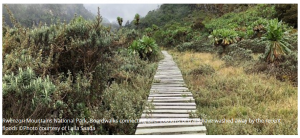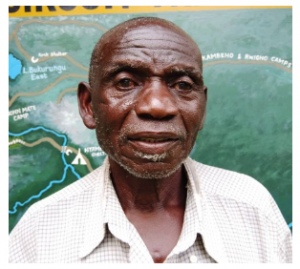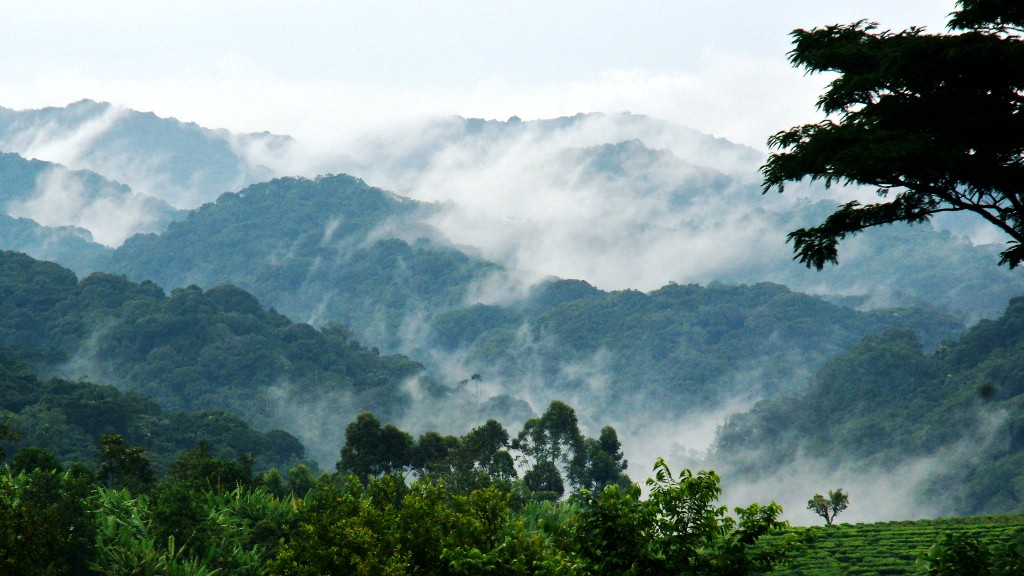For Mathumu Paul, a typical September morning would have started with an early breakfast around 6am and a trip to Kilembe Trailhead to meet with his hiking clients and finalize their multi-day trek checklist before they set off. September would have been a busy month in the Rwenzori Mountains National Park. Paul is a mountain porter with the Rwenzori Mountain Services (RMS) with over 25 years of portering experience on the mountains.
Today, he sits idly at noon waiting for his first meal. With no prospective clients due to the double devastating impact of the COVID-19 lockdown and the floods that destroyed all access to the mountains back in May, Paul has reduced his food intake to two minimal meals. He no longer has a reason to start his days early.
“I used to spend eight to ten days on the mountains earning my living as a porter. Then I would go back home with enough money to sustain my family and educate my children. I would stay home three or four days and then go back up the mountains again,” said Paul. The 2018 government statistics showed a steady increase of visitors to the park reaching close to 5000 visitors for that year. Since April 2020, only a handful of local trekkers have visited the park.
A few kilometers north of the Equator on the Uganda – Congo border, the Rwenzori Mountains National Park World Heritage Site is a fragile ecosystem of global interest on ecological, economic and cultural levels. The protected mountain range spans 1000 square kilometers and is an important source of resources for local communities. The communities that live on the slopes of the mountains derive their livelihood from the park for resources like medicinal plants, mushrooms, water, firewood, honey, fibers, dry bamboo stems and bamboo sheath. More than 1500 community members work as daily porters, guides and cooks for tourists who trek and climb over 260 kilometers of mountain trails and glacier summits.
Tourism on the mountains was immediately impacted in mid-March 2020, when COVID-19 was pronounced a global pandemic and airlines around the world grounded their flights. For the thousands of Ugandans living off of tourism revenues from the Rwenzori Mountains National Park, life came to a sudden standstill.
“Since the start of Covid-19, businesses came to a standstill. Due to the countrywide lockdown, people had to come back and converge in their villages. Now the competition for food is there. No money can be seen. In addition, we had the floods disaster. Crops were destroyed, houses were broken, and so many things dead. People are now scattered in camps. They have nowhere to live and survival means are very hard. That’s where we are now,” lamented Paul.
At the beginning of May 2020, torrential rain devastated areas on and around the Rwenzori Mountains National Park. Heavy flooding destroyed mountain habitats and entire villages were swept away, leading to loss of life and massive destructions of infrastructure of bridges, ladders and walk-boards. Arable land and gardens, homes, equipment, shelters and other properties were swallowed by the water, forcing people to congregate in makeshift camps.
“Our foot bridges were swept away. They [the floods] deepened the valleys and people are (now) stranded. They cannot cross over to reach their gardens and their crops. Those people look at the mountain to poach and to illegally lumber in order to get money,” said Paul.

No Visitors, no Revenue
COVID-19 has reduced the number of visitors and, as a result, park revenues dropped from an average of 150 million to 40 million UGX (around 40 thousand to 11 thousand USD) in 2020. July and August 2020 together saw a drop to 5 million UGX (1,350 USD), less than two percent of the 229 million UGX (62 thousand USD) of revenue yielded over the same period in 2019. Most are local tourists who started trickling in when local travel ban was recently lifted.
Furthermore, the valleys up the mountains have widened from 40 to 100 meters. With bridges, boardwalks and ladders destroyed or washed away, rangers have to rely on old poachers’ routes to access the highest and deepest parts of the park.
More than twelve bridges are needed to access the park for management and tourism. Because of the landslides, most of the 260-kilometer trails were destroyed and the infrastructure was washed away.
“We had to reduce operational funds. [This resulted in] a sudden stop of awareness campaigns, support to livelihood projects as well as reduced revenue sharing. We used to lead awareness-raising meetings with communities. Without access to the park, now we can’t. This has raised a lot of issues, one of them is poaching,” said James Ilukol Okware, Senior Warden with the Uganda Wildlife Authority, in charge of the Rwenzori Mountains National Park.
“Many organizations have laid off all their workers. Porters, guides and cooks, more than one thousand of them have lost their livelihoods. It’s understandable but it is hard to manage. They don’t have alternatives for survival, so they turn to the park as a source for livelihoods.”
 Rwenzori Mountains National Park, Mate Moses, 67, retired guide. He joined senior school for only two years and dropped out because his father could not afford the fees. He became a porter at the age of 18 and at 48 he became a Peak guide. Margherita Peak stands at 5,109 m above sea level. It is the highest peak in the Rwenzori mountain range.
Rwenzori Mountains National Park, Mate Moses, 67, retired guide. He joined senior school for only two years and dropped out because his father could not afford the fees. He became a porter at the age of 18 and at 48 he became a Peak guide. Margherita Peak stands at 5,109 m above sea level. It is the highest peak in the Rwenzori mountain range.
The National Park as a source for livelihoods
The loss of bridges, ladders and walk-boards is a burden to the local communities whose livelihoods depend on access to the park. Rangers lost their access routes into the densest parts of the mountains. As villagers turn to poaching for survival, the protection of the World Heritage site’s biodiversity, especially in these difficult moments of COVID-19, becomes a serious challenge. The lack of patrols is a big threat to the survival of biodiversity and protection of tourism property within the mountain huts. Uncontrolled timber harvesting will reduce the amount of trees, which may result in more landslides, devastating effects of climate change and soil erosion.
“Most of our communities bordering the mountains work as porters and guides. Ever since the COVID-19 and floods, they have resorted to poaching and illegal wood lumbering to survive. With children out of school, they get into trouble too,” said Nakukunda Alice Community Conservation Warden for the Rwenzori Mountains National Park. Alice’s family has been impacted by COVID-19 lockdown. Some of her children remain in Kampala, more than a 7-hour drive away.
“The rate of our visits [to see my children] is really low due to COVID-19. Even when they lifted the lock-down, it was still hard because we found that transport fees have increased,” she said.
Alice works on community awareness and sustainable livelihood projects with communities adjacent to the park. Her projects cover 100 community groups in five districts with an average of 4000 to 5000 beneficiaries reached. Since COVID-19, community outreach programs have stopped. Criminal activities have spiked as a result.
“I have seen members of my community being arrested for poaching or illegally harvesting wood. The other family members always approach me requesting their release. Every day I have to receive those requests. It’s just very hard,” she said.
Bridges for livelihoods
In order to support Uganda in safeguarding the World Heritage values of Rwenzori Mountains National Park, UNESCO is providing emergency assistance through a 75,000 USD grant from the World Heritage Fund for the reconstruction of management infrastructure of the park and the development of a disaster and risk management plan for the World Heritage property. The new designs for the infrastructure will ensure reduced vulnerability of the Rwenzori Mountains National Park to natural disasters, and will enable the site managers to access and manage the park throughout the year despite the recurrent tough weather conditions.
The designation and safeguarding of World Heritage sites is a renowned UNESCO mandate, but never before has the need to amplify the significance of these sites to global recovery efforts been more acute. The devastating socio-economic impact of COVID-19 has left countries searching for ways to recover, revitalize growth and create new opportunities to restore sites and livelihoods. Moreover, the risks of destruction and degradation due to both man-made and natural causes is increasing as we witness the destructive impacts of floods, fires, and extreme weather patterns due to climate change. Heritage sites are also threatened due to possible neglect as resources are redirected towards lifesaving and other more urgent national expenditures. However, as economies re-open and tourism starts to pick up, our World Heritage sites will become crucial elements of that recovery process, creating jobs and income that countries can ill afford to forgo.
Ms. Ann Therese Ndong-Jatta, Director of the UNESCO Regional Office for Eastern Africa

Guides and porters out of jobs as tourism comes to a standstill as a result of COVID-19 ©Photo courtesy of RTS
Gathering at the Central Circuit gate of the national park on a cloudy September morning, guides and porters share their worries about a sustainable livelihood for their families. With no immediate income in sight and tourism droughts due to COVID-19 travel restrictions, a temporary recruitment on the project for the rehabilitation of the bridges and the trails, is a lifeline.
Mathumu Paul stands with at least a dozen community members including, Hariet Tasesa and Mask Jovial, two brave female porters but also mothers who struggle to get by after the floods. Their pleas for help are twined with some hesitant hopeful smiles. The mountain frames their backdrop, a testament of resilience against climate disasters and global crisis. They reach out together and clap their hands as they receive news of the rebuilding of five bridges through the UNESCO grant.
“We will have work as porters in the construction of those bridges and we will be able to support our families,” said one porter in the group.
“We have our gardens across the rivers, if we can have access and connect to our gardens, we may also get to our crops and sell them as a means for living,” added another.
“The Rwenzoris are a World Heritage Site, we need you to market us,” added one mountain guide. “When you market us, we want the world to see a colorful community and not an ugly face for us. We are hoping to get tourist back, if this COVID-19 goes away. This is our prayer.”

